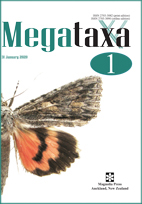Abstract
Documenting, naming and classifying the diversity of life on Earth provides baseline information on the biosphere, which is crucially important to understand and mitigate the global changes of the Anthropocene. We should meet three main challenges, using new technological developments without throwing the well-tried and successful foundations of Linnaean nomenclature overboard. 1. Fully embrace cybertaxonomy, machine learning and DNA taxonomy to ease, not burden the workflow of taxonomists. 2. Emphasize diagnosis over description, images over words. 3. Understand promises and pitfalls of omics approaches to avoid taxonomic inflation.
References
Brooke, M. de L. (2000) Why museums matter. Trends in Ecology and Evolution, 15, 136–137.
https://doi.org/10.1016/S0169-5347(99)01802-9
Bickel, D. (2009) Why Hilara is not amusing: the problem of open-ended taxa and limits of taxonomic knowledge. In: Pape, T., Bickel, D. & Meier, R. (eds.) Diptera Diversity: Status, Challenges, and Tools. Brill, Leiden, pp. 279–301.
Bik, H.M. (2017) Let’s rise up to unite taxonomy and technology. PLoS Biology, 15, e2002231.
https://doi.org/10.1371/journal.pbio.2002231
Crous, P.W., Gams, W., Stalpers, J.A., Robert, V. & Stegehuis, G. (2004) MycoBank: an online initiative to launch mycology into the 21st century. Studies in Mycology, 50, 19–22.
de Queiroz, K. (2007) Species concepts and species delimitation. Systematic Biology, 56, 879–886.
https://doi.org/10.1080/10635150701701083
De Mauro, A., Greco, M. & Grimaldi, M. (2016) A formal definition of Big Data based on its essential features. Library Review, 65, 122–135.
https://doi.org/10.1108/LR-06-2015-0061
Güntsch, A., Groom, Q., Hyam, R., Chagnoux, S., Röpert, D., Berendsohn, W., Casino, A., Droege, G., Gerritsen, W., Holetschek, J., Marhold, K., Mergen, P., Rainer, H., Smith, V. & Triebel, D. (2018) Standardised globally unique specimen identifiers. Biodiversity Information Standards, 2, e26658.
https://doi.org/10.3897/biss.2.26658
Heerlien, M., Van Leusen, J., Schnörr, S., De Jong-Kole S, Raes, N. & Van Hulsen, K. (2015) The natural history production line: An industrial approach to the digitization of scientific collections. ACM Journal on Computing and Cultural Heritage, 8, 3.
https://doi.org/10.1145/2644822
IISE (2011) State of Observed Species. Tempe, AZ. International Institute for Species Exploration. Available from: http:/species.asu.edu/SOS (Accessed 15 March 2019).
Larsen, B.B., Miller, E.C., Rhodes, M.K. & Wiens, J.J. (2017) Inordinate fondness multiplied and redistributed: the number of species on Earth and the new pie of life. Quarterly Review of Biology, 92, 229–265.
https://doi.org/10.1086/693564
Lendemer, J., Thiers, B., Monfils, A.K., Zaspel, J., Ellwood, E.R., Bentley, A., LeVan, K., Bates, J., Jennings, D., Contreras, D., Lagomarsino, L., Mabee, P., Ford, L.S., Guralnick, R., Gropp, R.E., Revelez, M., Cobb, N., Seltmann, K. & Aime, M.C. (2019) The extended specimen network: a strategy to enhance US biodiversity collections, promote research and education. BioScience, biz140,
https://doi.org/10.1093/biosci/biz140
Nelson, G. & Ellis, S. (2018) The history and impact of digitization and digital data mobilization on biodiversity research. Philosophical Transactions of the Royal Society B, 374: 20170391.
https://doi.org/10.1098/rstb.2017.0391
Padial, J.M., Miralles, A., De la Riva, I. & Vences, M. (2010) The integrative future of taxonomy. Frontiers in Zoology, 7, e16.
https://doi.org/10.1186/1742-9994-7-16
Patterson, D.J., Cooper, J., Kirk, P.M., Pyle, R.L. & Remsen, D.P. (2010) Names are key to the big new biology. Trends in Ecology and Evolution, 25, 686–691.
https://doi.org/10.1016/j.tree.2010.09.004
Renner, S.S. (2016) A return to Linnaeus’s focus on diagnosis, not description: The use of DNA characters in the formal naming of species. Systematic Biology, 65, 1085–1095.
https://doi.org/10.1093/sysbio/syw032
Riedel, A., Sagata, K., Surbakti, S., Tänzler, R. & Balke, M. (2013) One hundred and one new species of Trigonopterus weevils from New Guinea. Zookeys, 280, 1–150.
https://doi.org/10.3897/zookeys.280.3906
Roskov, Y., Ower, G., Orrell, T., Nicolson, D., Bailly, N., Kirk, P.M., Bourgoin, T., DeWalt, R.E., Decock, W., Nieukerken, E. van, Zarucchi, J. & Penev, L. (Eds) (2019) Species 2000 & ITIS Catalogue of Life, 26th February 2019. Digital resource at www.catalogueoflife.org/col. Species 2000: Naturalis, Leiden, the Netherlands. ISSN 2405-8858.
Rupp, K. (2018) 42 Years of Microprocessor Trend Data. Website. Available from: https://www.karlrupp.net/2018/02/42-years-of-microprocessor-trend-data/ (Accessed 13 March 2019)
Ratnasingham, S., Hebert, P.D. (2013) A DNA-based registry for all animal species: the barcode index number (BIN) system. PLoS One, 8, e66213.
https://doi.org/10.1371/journal.pone.0066213
Srivathsan,A., Ang, A., Vogler, A.P. & Meier, R. (2016) Fecal metagenomics for the simultaneous assessment of diet, parasites, and population genetics of an understudied primate. Frontiers in Zoology, 13, 17.
https://doi.org/10.1186/s12983-016-0150-4
Srivathsan, A., Hartop, E., Puniamoorthy, J., Lee, W.T., Kutty, S. N., Kurina, O. & Meier, R. (2019) Rapid, large-scale species discovery in hyperdiverse taxa using 1D MinION sequencing. BMC Biology, 17, 96.
https://doi.org/10.1186/s12915-019-0706-9
Sukumaran, J. & Knowles, L.L. (2017) Multispecies coalescent delimits structure, not species. Proceedings of the National Academy of the United States of America, 114, 1607–1612.
https://doi.org/10.1073/pnas.1607921114
Tegelberg, R., Mononen, T. & Saarenmaa, H. (2014) High-performance digitization of natural history collections: Automated imaging lines for herbarium and insect specimens. Taxon, 63, 1307–1313.
https://doi.org/10.12705/636.13
Wheeler, Q.D., Knapp, S., Stevenson, D.W., Stevenson, J., Blum, S.D. , Boom, B.M., Borisy, G.G., Buizer, J.L., De Carvalho, M.R., Cibrian, A., Donoghue, M.J., Doyle, V., Gerson, E.M., Graham, C.H., Graves, P., Graves, S.J., Guralnick, R.P., Hamilton, A.L., Hanken, J., Law, W., Lipscomb, D.L., Lovejoy, T.E., Miller, H., Miller, J.S., Naeem, S., Novacek, M.J., Page, L.M., Platnick, N.I., Porter-Morgan, H., Raven, P.H., Solis, M.A., Valdecasas, A.G., Van Der Leeuw, S., Vasco, A., Vermeulen, N., Vogel, J., Walls, R.L., Wilson, E.O. & Woolley, J.B. (2012) Mapping the biosphere: exploring species to understand the origin, organization and sustainability of biodiversity. Systematics and Biodiversity, 10, 1–20.
https://doi.org/10.1080/14772000.2012.665095


